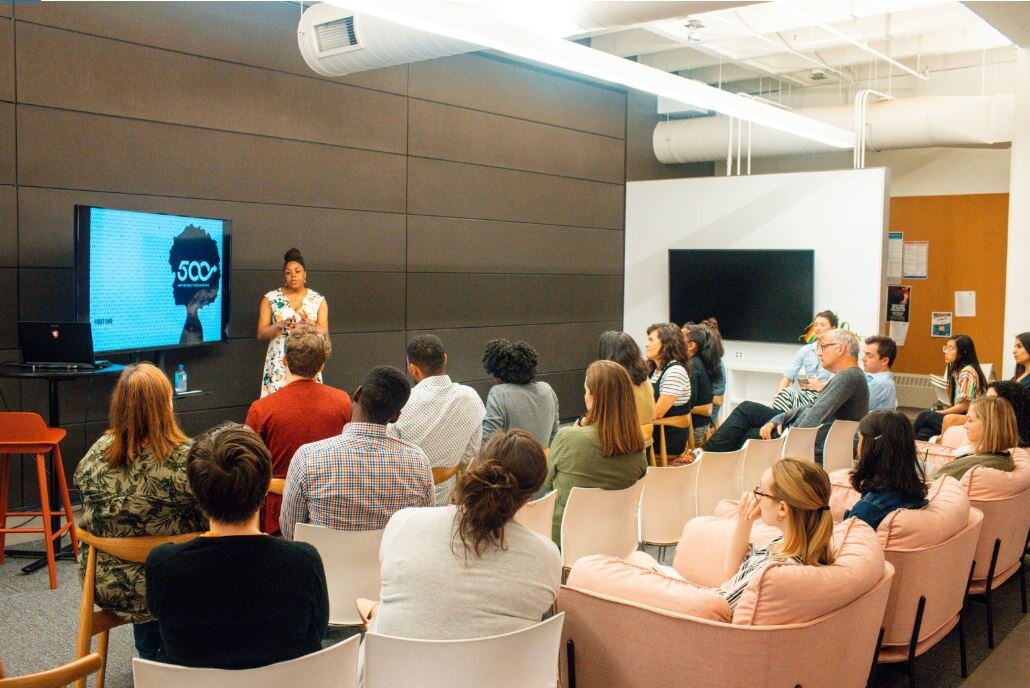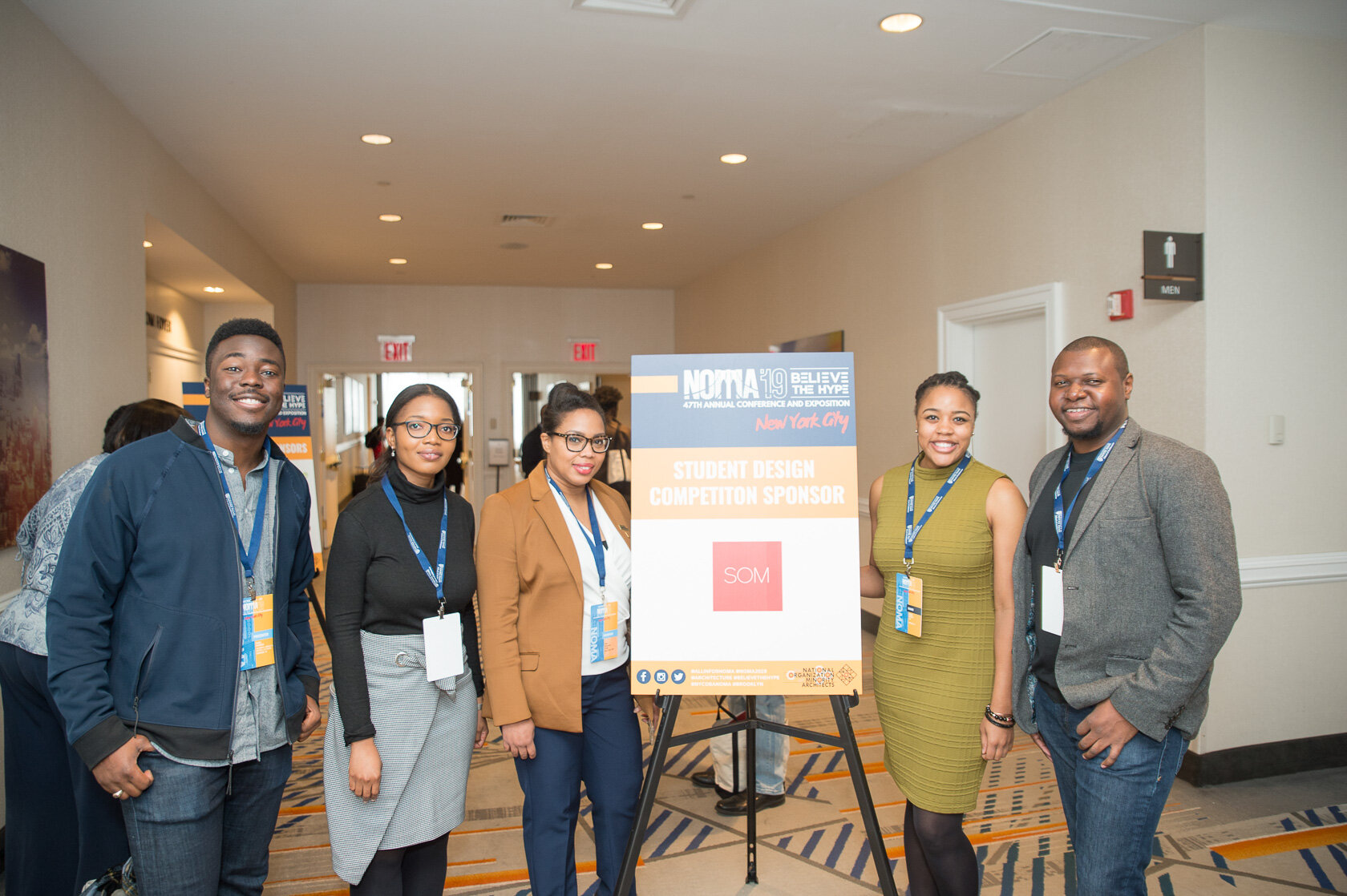TIARA HUGHES
Photograph by SOM. Portrait courtesy of Tiara Hughes.
Senior Urban Designer at Skidmore, Owings & Merrill (SOM)
Graduate of Drury University
A St. Louis native, now based in Chicago, Tiara Hughes is a Senior Urban Designer at Skidmore, Owings & Merrill (SOM), an adjunct professor at the Illinois Institute of Technology, a Commissioner with the City of Chicago Landmarks Commission, and a real estate professional.
She is a devoted activist, educator, and advocate for underrepresented communities and voices, and currently serves on the Board for the National Organization of Minority Architects (NOMA) and the Charnley-Persky House Board of Directors for the Society of Architectural Historians. Tiara's personal experiences in the industry along with her passion for advocacy led her to establish a national research initiative called FIRST 500 in 2018. As the Founder and Executive Director of FIRST 500, Tiara travels the country to raise awareness of the importance of Black women architects throughout history and their contribution to the built environment.
Tiara is a believer in giving back to her community, serving as a Co-Leader of SOM’s ACE Mentorship Program in Chicago. As a designer, Tiara is driven by creating work that emphasizes greater socioeconomic equity and cultural awareness. She believes "Ultimately our efforts to positively impact communities of color will expand outward and evolve our academic institutions, our firms, our industry and by extension, our communities." In 2021, Tiara received the prestigious AIA Associates Award, given by the Institute to associate members who best exemplify the highest qualities of leadership and have demonstrated an unparalleled commitment to their component or region’s membership.
Preventing History from Repeating Itself through First 500, Urban Design, Education, and Mentorship
What inspired you to pursue a career in architecture?
I was accepted into a gifted arts program in second grade. Each year we had a fundraiser where we created artworks of our choice and the proceeds went to providing gifts for every child in the school. For my contribution, I drew buildings from books and magazines. The following year, I saw blueprints for the first time and although they aren’t around anymore, I will never forget the smell of the ink and feel of those prints. Understanding how to read a blueprint was unheard of at my age; the person who designed my experience of space was the person I wanted to be when I grew up. The following year someone connected the dots for me when they said, “Tiara, you want to be an architect.”
Photograph by Dawveed Scully. Image courtesy of Tiara.
Tell us about your research initiative, First 500. How do you hope the initiative will inspire future generations of African-American aspiring architects to pursue architecture and feel supported among this network?
My personal experiences in the industry along with my passion for advocacy led me to establish a national research initiative called FIRST 500 in 2018. As the Founder and Executive Director of FIRST 500, I travel the country to raise awareness of the importance of black women architects throughout history and their contributions to the built environment. These women serve as inspiration and motivation for the black women looking to become licensed and those studying in our universities to graduate and enter the field.
Photograph by Kai Brown. Image courtesy of Tiara.
For many centuries, architecture has been and continues to be a white-male-dominated field. However, design begins with the community, which is heavily lacking representatives in the industry. As an urban designer at SOM, what are some initiatives that you have taken to ensure diversity and inclusion are present within a large-scale and well-known firm?
I’m the founding co-chair of SOM’s Equity Action Committee (EAC), an inclusive group grounded by SOM’s unique culture with a focus on making the firm an equity leader in our industry. EAC focuses on advocacy, engagement, recruitment, and retention, among other goals.
I’ve also pushed for a more equitable workplace through the creation of our Equity, Diversity, and Inclusion (EDI) Plan, a collaborative effort between SOM employees and leadership, and continuing dialogue around EDI through events and programming throughout the year. My hope is through these measures, we can open people’s minds and hearts to a more inclusive industry.
Fostering the next generation of designers is also key to my work. At SOM, this means securing designated spots for NOMAS students to join our annual global shadowship week. This ensures more BIPOC students gain early exposure and mentoring in the industry. More recently, I was a part of a group that helped create the SOM Foundation’s Robert L. Wesley Award for BIPOC undergraduate students enrolled in architecture, landscape architecture, urban design, or structural engineering programs across the US. Providing these kinds of opportunities and infrastructure for young designers of color is key to fostering our industry’s future leaders.
Image courtesy of SOM.
As an Adjunct Professor at the Illinois Institute of technology, what are some of the ways you integrate social justice into the curriculum?
My colleagues and I have essentially flipped the traditional studio culture on its head because typically students are given a prompt, site, and program to design for. However, we jointly chose a community to work with (Englewood) and had our students do research and connect with local residents. Based on all of their findings, students then selected their own sites and program and continuously touch base with the community throughout the semester. This approach not only bridges the gap between how we work in the real world but also introduces an equitable design methodology to academia.
Photograph by Dawveed Scully. Image courtesy of Tiara.
Tell us about your role as a National Board Member and Elevate Co-Chair of the National Organization of Minority Architects (NOMA).
I serve on the National Board for NOMA. My community impact work has always been some of my proudest. As the ELEVATE Co-Chair, I have introduced two of our newest platforms: NOMA Voices and NOMA Spotlight!
NOMA Voices allows me to interview various NOMA Members to share their stories and how NOMA has influenced their careers and daily lives. This platform will serve as a source for elevating and celebrating our members through the lens of NOMA National. NOMA has become the go-to resource for industry leaders and media searching for talented people of color. Narratives shared will give members the opportunity to convey the impact of NOMA to the industry at large.
NOMA Spotlight is a platform that recognizes and celebrates our chapters and allied entities for their contributions to NOMA, the industry, and our communities. NOMA’s mission, rooted in a rich legacy of activism, is to empower our local chapters and membership to foster justice and equity in communities of color through outreach, community advocacy, professional development, and design excellence.
Additionally, I offer my thought leadership at our board strategy sessions and meetings. I am honored to contribute to our National Board in such an impactful way.
Image courtesy of NOMA.
What inspired you to Co-Lead and participate as a Mentor at ACE Chicago? What inspired you to give back to high schoolers who wish to study within the fields of Architecture, Construction, or Engineering?
The quality of education and access to the various aspects of the STEM ranges drastically in different locations. For instance, I was fortunate enough to attend a high school that had engineering and architecture courses as an option. Even within the PWI environment, I can honestly say these options were not widely advertised to the other minority and female students because I was the only student of color and only girl in my STEM classes for all four years of high school. Serving as a leader for ACE ensures that I am preventing history from repeating itself. This is also a moment for me to connect with black girls interested in architecture and design roles and follow their careers while serving as a resource throughout their journeys.
Image courtesy of SOM.
Based on your roles as an emerging professional, educator, and mentor, what is the importance of guiding the next pipeline? How do you convince others to partake in these roles to support the next generations and encourage the future generations to become the next and greater designers in the built industry?
Guiding the future pipelines of black voices is critical to the survival and growth of our industry. Our voices are needed in spaces where decisions are made, policies are considered, and positions of leadership and power are given. We offer a different lens and point of view that’s often missing from these spaces.
For those of us professionals designing our cities and buildings, this is our CALL TO ACTION. It is a time for us to:
Internally reflect
Listen and educate yourself
Don’t be defensive
Hire more Black people
No more excuses
Equitably approach
Revisit our policies
We should all be intentional about changing the discourse and creating a better space for all designers. In turn, our industry will become more inclusive to better reflect the communities we serve.
Photograph by Kai Brown. Image courtesy of Tiara.
What is one piece of advice for the next generation of aspiring women architects?
When considering what advice to pass along, I often think of what I would tell my younger self when I was homeless in college, fighting to survive and to get my architectural education; when my professors and advisors continuously told me this field and industry may not be right for me. I would tell my younger self, and to young women everywhere: if this industry feels lonely, you are not alone. If your ideas are not heard, keep speaking. If one door closes, three will open. Keep going and never give up. If there is no well to drink from, dig until you create one!
Photograph by Dawveed Scully. Image courtesy of Tiara.
In terms of rising concerns and problems (in the architectural profession) over the past year, what is one change that you wish you saw would happen and still, it did not?
Design firms and the industry at large have discussed “equality of opportunity” as a remedy to systemic racism in America. Equality is not the solution; many black employees have experienced decades of economic and emotional trauma stemming from redlining, policing, environmental exploitation, pay inequity, and more. They bring these burdens with them into the workplace, which ensures “equality” by providing employees with the same resources for success without acknowledging those previous burdens. Acknowledgment has occurred to an extent following the murder of George Floyd, but our country’s collective mindset has to shift from equality to equity. Equity means meeting people where they are and addressing their needs accordingly.
Photograph by Dawveed Scully. Image courtesy of Tiara.











